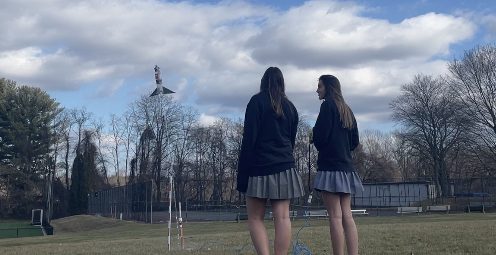Honors Physics classes create and launch rockets

February 14, 2023
Honors Physics has three different class sections at John Carroll, all taught by Dr. Anthony Davidson. All of the classes are working on a year-long project: to create a functional rocket. So far each class has launched their rockets three times in order to test them.
Dr. Davidson commented, “Launching and building rockets helps students see a practical application of the concepts we learn in class. It also provides the ability to build critical thinking skills on what can improve the results of the launches.”
Each individual class has their own groups who all make different rockets. The goal is to create one that goes straight up and down, while being able to land softly with a parachute. Students record their launches to put in a software that allows them to track the rocket’s velocity and acceleration.
The only requirements for the rockets are that they are made up of some kind of plastic bottle. All of the other elements are up to the creative liberty of the students, and that makes each rocket unique.
Each rocket is water-powered and put onto a launcher that Dr. Davidson created himself. As the year continues, the students will add more and more, including coding and measurement tools, to improve the rocket.
Chris Dattoli, a student in one of the Physics classes, said “I think building rockets in Physics is cool because it allows us to get hands-on experience, and it helps us learn in a fun way.”
Currently, classes are working on building parachutes for their rockets. To prepare for adding parts to the rocket, Dr. Davidson assigns labs that relate to the additions.
For example, he assigned a lab on how to measure air resistance so students would learn how to find it when making their parachutes.
Students are given multiple class periods to work on their rockets with their groups. Groups usually come in three to four people, but there may be more depending on how big their table is.
Students are graded on labs, but the rockets are not since they are continuously worked on throughout the year.
Students can use different weights, hot glue, and other objects for modification.
Each lab ends up helping students to understand the physics concepts themselves so that they can be applied in the projects.
Once this portion of the rocket is complete, the action and concepts behind the rise of the rocket would be understood while the parachute would teach the students about the falling action and the force of gravity on rockets returning to the ground.
Angelina DiCocco, a student in one of the Physics classes, said, “I think it is really fun and helps me to understand physics better when we are doing interactive activities like this.”
Getting an experience like this is one of the many unique learning experiences that John Carroll offers. It makes the lessons learned in physics more easily able to be learned and retained.
Previous physics student Sierra Simmons said this about her experience, “Building rockets was one of my favorite experiences while taking a class at John Carroll. It felt so good to see the final product that me and my group were able to launch and know that we did it all on our own.”


